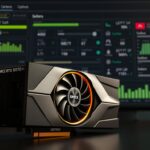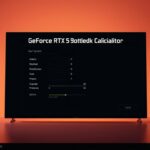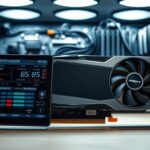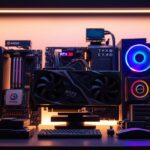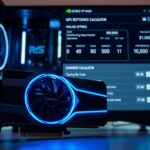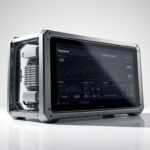Last Updated on August 7, 2025 by Gill
Remember that moment when your favorite game stuttered during a critical scene? Or when your video editing software lagged just as inspiration struck? These frustrations often trace back to one component—the silent workhorse shaping every pixel you see.
Whether you’re a casual user or a creative professional, your device’s visual capabilities depend on its graphics processor. Modern machines use two types: integrated solutions built into the main processor, and dedicated units with independent power and memory. The difference between them can mean smoother gameplay, faster rendering, or seamless multitasking.
This guide simplifies the process of discovering your system’s visual strengths. We’ll explore easy-to-use tools within your operating system and third-party applications that reveal critical details. You’ll learn to interpret specifications like VRAM capacity, clock speeds, and processor architecture—factors that directly impact performance in demanding tasks.
Why does this matter? Matching your hardware’s capabilities to your needs prevents unexpected limitations. Gamers can optimize settings for buttery-smooth frame rates. Content creators gain clarity on rendering timelines. Even everyday users benefit from understanding their system’s potential when upgrading displays or troubleshooting visual glitches.
Let’s begin this journey by demystifying technical jargon and focusing on practical insights. By the end, you’ll confidently navigate your device’s graphical capabilities like a seasoned tech enthusiast.
Understanding GPU Memory and Its Importance
Ever wondered why some games run buttery-smooth while others stutter? The answer often lies in your system’s visual workspace—the specialized memory handling every pixel. This temporary storage determines how quickly your device processes complex textures, animations, and effects.
The Role of VRAM in Graphics Performance
Visual tasks require instant access to textures and frame data. Dedicated video memory acts like a high-speed warehouse, keeping essential elements ready for rapid use. Newer memory types like GDDR6 deliver data 50% faster than older versions, making modern games and 4K video editing possible.
| Feature | Integrated Graphics | Dedicated Graphics |
|---|---|---|
| Memory Source | Shared system RAM | Independent VRAM |
| Performance | Basic tasks | Demanding applications |
| Power Use | Energy-efficient | Higher consumption |
Integrated vs. Dedicated Graphics Explained
Most laptops use integrated solutions for everyday browsing and office work. These share your computer’s main memory, which works fine for streaming videos or casual gaming. Dedicated units, however, come with their own memory reserves—ideal for rendering 3D models or playing AAA titles at maximum settings.
Pro tip: Content creators working with 8K footage or VR projects should aim for at least 8GB dedicated memory. This prevents slowdowns when handling large files or complex simulations.
Defining Key Graphics Card Specifications
Imagine launching a new game only to face choppy visuals and endless loading screens. This struggle often stems from mismatched hardware capabilities. To avoid frustration, understanding three critical elements becomes essential: parallel processing power, operational speed, and display clarity.
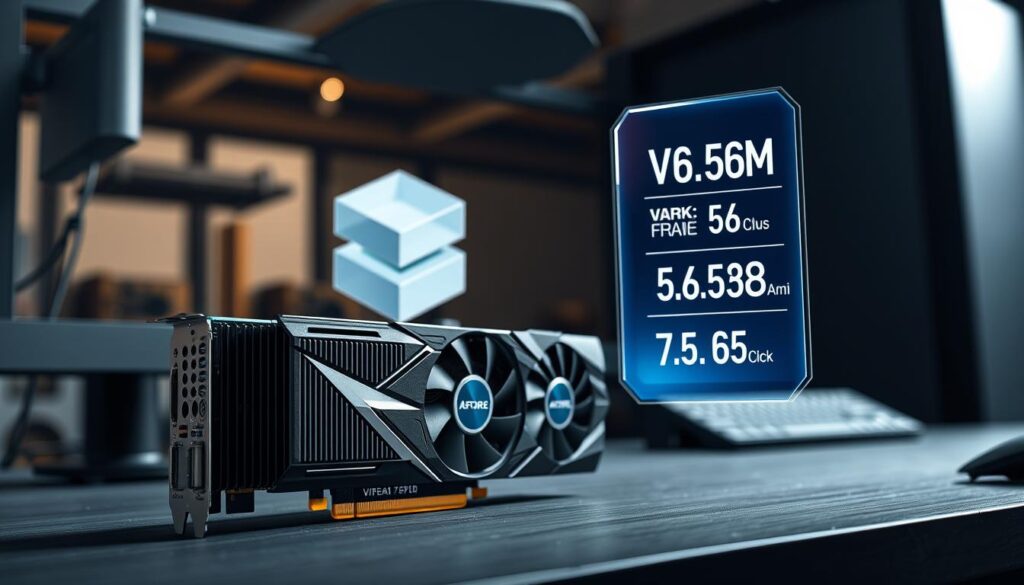
Core Count, Clock Speed, and Resolution
Think of cores as workers in a visual factory. More cores mean faster rendering of complex scenes. Modern units range from 1,000 to 10,000+ processing units. Speed matters too—measured in MHz, clock rates determine how quickly each core operates.
Higher resolutions demand more resources. A 4K display requires four times the pixels of 1080p. Your hardware must keep up with both detail levels and refresh rates for smooth motion.
| Task | Recommended Cores | Ideal Clock Speed | Resolution Target |
|---|---|---|---|
| Casual Gaming | 1,500-2,500 | 1,500 MHz | 1920×1080 |
| 4K Streaming | 3,000-4,500 | 1,800 MHz | 3840×2160 |
| 3D Rendering | 5,000+ | 2,000 MHz | Multi-monitor |
Memory Matters in Visual Tasks
Specialized memory acts as a temporary storage for textures and effects. Capacity determines how much data stays readily available. While 4GB handles basic 1080p games, modern titles at maximum settings often require 8GB or more.
Content creators face similar demands. Editing 8K footage or layered animations needs robust memory reserves to prevent stuttering during playback. Pro tip: Match your memory capacity to both current needs and future projects.
| Use Case | Minimum Memory | Recommended |
|---|---|---|
| 1080p Gaming | 4GB | 6GB |
| 4K Video Work | 8GB | 12GB+ |
| VR Experiences | 8GB | 10GB+ |
Uncovering Your Device’s Visual Capabilities
Ever paused mid-project because your screen froze during a video conference? Modern operating systems hide powerful diagnostic tools right under your fingertips. Let’s explore three built-in methods to reveal your machine’s graphical potential without installing extra software.
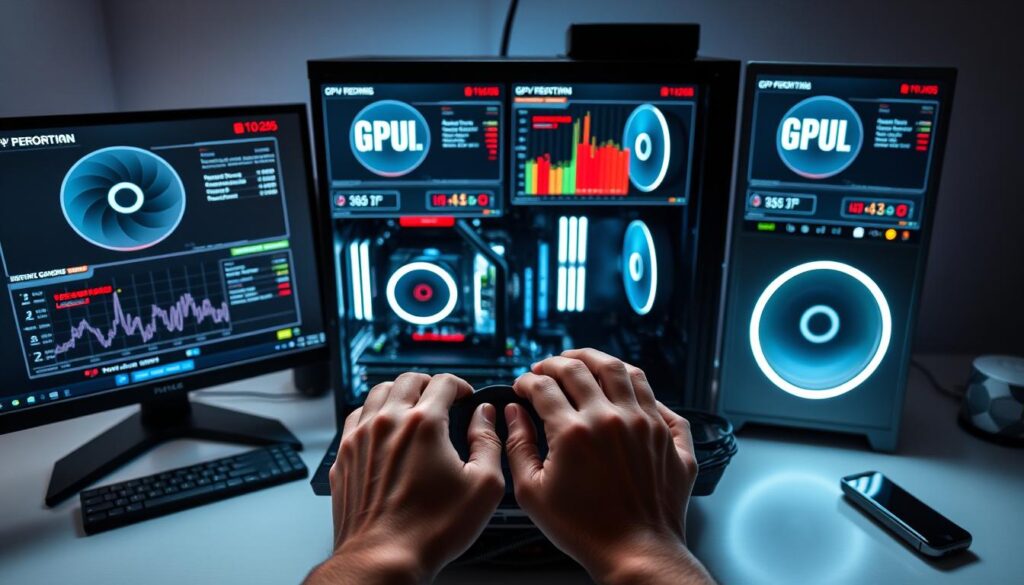
Display Settings Exploration
Navigate to Windows Settings through the Start menu. Select the System category, then choose Display. Scroll to “Advanced display” for instant access to your primary monitor’s connected graphics solution. This area shows your active adapter name and basic specs—ideal for quick verification.
Performance Insights and System Reports
Open Task Manager using Ctrl+Shift+Esc. Switch to the Performance tab and locate the GPU section. Here you’ll find real-time usage graphs alongside dedicated memory allocation details. For deeper technical data, search “System Information” in the Start menu. Expand the Components section and select Display to view driver versions, resolution support, and adapter RAM specifications.
| Method | Steps | Details Provided | Best For |
|---|---|---|---|
| Display Settings | Start → Settings → System → Display | Adapter name, Basic specs | Quick verification |
| Task Manager | Ctrl+Shift+Esc → Performance | Live usage, Memory allocation | Performance monitoring |
| System Information | Start search → Components → Display | Driver versions, Resolution support | Technical troubleshooting |
These native tools work across all major hardware brands. Casual users appreciate the simplicity of Display Settings, while creators benefit from System Information’s comprehensive reports. Pro tip: Bookmark the Performance tab for instant access during resource-heavy tasks like 3D rendering or 4K video playback.
Utilizing the DirectX Diagnostic Tool (DxDiag)
Picture this: You’re about to start a crucial presentation when mysterious screen artifacts appear. Microsoft’s built-in diagnostic utility becomes your first responder. The DirectX Diagnostic Tool offers a treasure trove of hardware insights through a simple interface.
Step-by-Step Process to Run DxDiag
Accessing this tool takes seconds. Press Windows + R, type dxdiag, then hit Enter. A progress bar appears while the system scans components. Within a minute, you’ll see tabs for each display adapter.
- Select your primary monitor tab (usually Display 1)
- Locate the Device section for model details
- Check Display Memory value for VRAM capacity
Interpreting the Display Tab Results
The Display tab reveals three critical data points. First, the Name field shows your exact graphics model. Second, memory values appear in megabytes—divide by 1024 to get gigabyte equivalents. Third, driver versions help verify software compatibility.
| VRAM Reading | Actual Capacity | Typical Use Case |
|---|---|---|
| 4096 MB | 4 GB | Basic gaming |
| 8031 MB | 8 GB | 4K content creation |
| 12288 MB | 12 GB | VR development |
Look for warnings in the Notes section—these indicate potential driver conflicts. Multiple display tabs help users with multi-monitor setups analyze each adapter separately. This tool remains indispensable for both troubleshooting and hardware verification.
Checking Graphics Card Information with Manufacturer Tools
Have you ever marveled at seamless ray tracing in games or instant video previews in editing software? Behind these experiences lies hardware that demands precise management. Manufacturer-specific software unlocks deeper insights than standard system tools, giving you command over your device’s visual capabilities.
Tailored Software for Precision Control
NVIDIA Control Panel transforms GeForce users into hardware conductors. Right-click your desktop to access detailed metrics like boost clock behavior and thermal limits. The interface reveals memory allocation patterns during 4K rendering or AI-enhanced tasks—data generic monitors can’t provide.
AMD Radeon Software matches this depth for Radeon devices. Its performance tab tracks real-time core utilization across multiple displays. Both platforms offer driver optimization presets for popular games and creative apps, adapting your card’s power to current demands.
| Feature | NVIDIA Control Panel | AMD Radeon Software |
|---|---|---|
| Live Monitoring | Temperature, clock speeds | Core usage, fan curves |
| Optimization | Game-ready profiles | Creative app presets |
| Advanced Controls | Ray tracing adjustments | VRAM allocation sliders |
Physical inspection offers instant verification. Most cards display model numbers on backplate stickers—compare these to manufacturer databases for exact specs. Retail boxes often list memory configurations, helping upgraders match new units to existing setups.
Pro tip: Bookmark your card maker’s support page. These hubs provide driver updates months before Windows detects them, along with detailed benchmarks for your specific model. Whether tweaking settings or troubleshooting, manufacturer tools turn guesswork into informed decisions.
Evaluating GPU Performance and Specification Metrics
Ever questioned whether your computer can handle that new design software or latest game release? Matching your hardware’s capabilities to your workload requires understanding three critical metrics. Let’s break down what matters most when analyzing visual power.
Understanding Core Counts and Clock Speeds
Visual processors work like teams of digital artists. NVIDIA calls them CUDA Cores, while AMD uses Stream Processors. More cores mean faster rendering of complex scenes. A mid-range card might have 2,500 cores, while high-end models boast over 10,000.
Clock speed determines how fast these cores operate. Base speeds ensure stable performance, while boost modes kick in during demanding tasks. Modern cards typically range from 1,500 MHz to 2,100 MHz. Pro tip: Higher speeds generate more heat—ensure proper cooling for sustained performance.
| Activity | Recommended Cores | Ideal Clock Speed |
|---|---|---|
| Office Work | 1,000-2,000 | 1,200 MHz |
| 1080p Gaming | 2,500-4,000 | 1,600 MHz |
| 3D Animation | 6,000+ | 1,800 MHz+ |
Assessing VRAM and Memory Speeds for Your Needs
Your visual workspace size matters. 4GB handles basic photo editing, while 8GB+ lets you work with 8K video layers. Memory type affects speed too—GDDR6X transfers data 40% faster than standard GDDR6.
Consider these scenarios:
- Casual gaming: 6GB GDDR6 handles most 1440p titles
- VR development: 10GB+ prevents texture loading delays
- 4K editing: 12GB+ ensures smooth timeline scrubbing
Thermal design power (TDP) completes the picture. High-performance cards often require 250-350 watts. Balance your power supply capacity with performance needs to avoid system instability.
Optimizing Graphics Settings for Better Performance
What if your favorite game could run smoother without expensive upgrades? The secret lies in smart configuration. Balancing visual quality with smooth operation starts with knowing your system’s limits and adjusting accordingly.
Modern titles often include memory usage meters in their options menus. These tools show real-time consumption of visual resources. Texture quality and shadow details typically eat the most memory—dial these down first if you notice stuttering during intense scenes.
Resolution choices dramatically affect performance. Dropping from 4K to 1440p can double frame rates while keeping images sharp. Many games now offer scaling options that render at lower resolutions but upscale intelligently.
Creative professionals face similar decisions. Video editors should monitor playback performance when working with high-bitrate footage. Lower preview resolutions during editing, then switch to full quality for final exports.
Pro tip: Bookmark your card’s specifications for quick reference. Match in-game settings to your hardware’s strengths for buttery-smooth gameplay and efficient content creation. Smart adjustments often deliver better results than hardware upgrades.
FAQ
Why is VRAM critical for gaming and video editing?
How do integrated graphics differ from dedicated GPUs?
Can I check VRAM without third-party software?
What do clock speed and core count mean for a GPU?
Does my GPU affect laptop performance for everyday tasks?
How do I optimize graphics settings for older GPUs?
What’s the easiest way to identify my GPU model?
- Optimize Your GeForce RTX 5070 Performance with Our Bottleneck Tool - October 2, 2025
- GeForce RTX 5090 Bottleneck Calculator: Optimize Your Setup - October 1, 2025
- GeForce RTX 5080 Bottleneck Calculator: Optimize Your Setup - September 30, 2025


